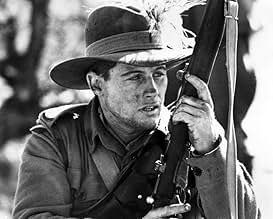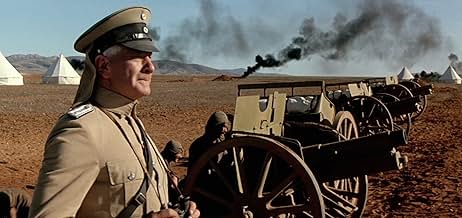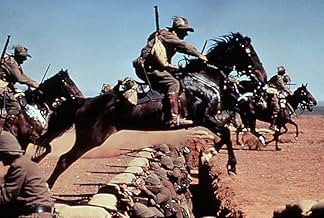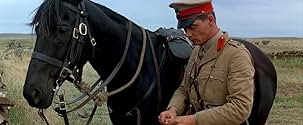CALIFICACIÓN DE IMDb
6.8/10
2.2 k
TU CALIFICACIÓN
En 1917, cuando las fuerzas británicas están empantanadas frente a las líneas turcas y alemanas en Palestina, confían en el regimiento australiano de caballos ligeros para salir del atollade... Leer todoEn 1917, cuando las fuerzas británicas están empantanadas frente a las líneas turcas y alemanas en Palestina, confían en el regimiento australiano de caballos ligeros para salir del atolladero.En 1917, cuando las fuerzas británicas están empantanadas frente a las líneas turcas y alemanas en Palestina, confían en el regimiento australiano de caballos ligeros para salir del atolladero.
- Dirección
- Guionista
- Elenco
- Premios
- 2 premios ganados y 1 nominación en total
Jack Heywood
- Dave's Dad
- (as John Heywood)
- Dirección
- Guionista
- Todo el elenco y el equipo
- Producción, taquilla y más en IMDbPro
Opiniones destacadas
Despite the ubiquitous appearance by Sigrid Thorton, and my having to eat crow over my previous comments on Anthony Andrew's acting ability (no scenery chewing or hamming it up here), I very much enjoyed this outstanding Aussie film.
Simon Wincer has directed a wide variety of films, some bad (like the Cheryl Ladd waste of celluloid "Bluegrass" and the turkey "Pharlap") and some very good (like the intense "Harlequin" and the great A&E mini "PT Barnum"). I find this one to be particularly special due to it containing one of the best war sequences on film.
Wincer and his crew have excellently interwoven a beautifully done drama with incredible special effects. The battle sequence at the end if the film is so powerful that even seen on video on an average size home TV it is astounding. Not only is the Lighthorsemen's assault wonderfully choreographed, but the reaction shots of the cast are well performed. You can see the private struggles going on in the face of the big one.
This is not a movie for the faint of heart nor should it be dismissed as just another war movie by those a little leery of the genre.
Simon Wincer has directed a wide variety of films, some bad (like the Cheryl Ladd waste of celluloid "Bluegrass" and the turkey "Pharlap") and some very good (like the intense "Harlequin" and the great A&E mini "PT Barnum"). I find this one to be particularly special due to it containing one of the best war sequences on film.
Wincer and his crew have excellently interwoven a beautifully done drama with incredible special effects. The battle sequence at the end if the film is so powerful that even seen on video on an average size home TV it is astounding. Not only is the Lighthorsemen's assault wonderfully choreographed, but the reaction shots of the cast are well performed. You can see the private struggles going on in the face of the big one.
This is not a movie for the faint of heart nor should it be dismissed as just another war movie by those a little leery of the genre.
This is an excellent film with surely the finest cavalry charge ever filmed. In this movie the horse is King and the care taken to illustrate the vital interaction between these magnificent animals and their riders is great to behold. The acting and direction are good without the need for big names. It has had a number of releases, the best being a 2.35 wide screen laser disc version in the USA. Australia has released a DVD version but it is dreadfully truncated being cut to 1.78 from the vastly more meaningful aspect ratio of the laser disc. On the big screen this film makes a fantastic impact and every effort should be made to see the original wide screen version in this way. Highly recommended.
This movie also has to go on my "desert island" list. What most people will say is that the first hour is about as exciting as watching paint dry, which is true to a point. But wars are often played like chess, and if you don't know the board you'll never understand the game. It's therefore necessary, though somewhat tedious, to show the situation, terrain, weather, and overall political climate to get to the historical charge. The Germans are played perhaps a little too stiffly, and the one Aussie who couldn't shoot a human and became a medic was perhaps given a little too much screen time. As for the charge itself, you can hear your heart beating faster as you literally smell the sweat from the horses. The two-mile charge against an entrenched enemy supported with machine gun, razor wire, and cannon is intense beyond words, and stands as some of the most awesome cinematography I've ever seen. Actual casualty stats are listed, which are surprisingly low. As for how the horses were handled, not one was injured-a feat you'll scarcely believe after having seen the charge. The Lighthorsemen, unlike Gallipoli, is well worth a look. -Chuck
This impressive flick is based on a true story and most of the characters in the film were based on real people and dealing with the continued coming of age of the Australian nation and its soldiers . The film follows Four Australians, Frank (Gary Sweet), Scotty (Jon Blake who was injured in a car accident and he suffered permanent paralysis and brain damage until his recent death) an Irish-Australian, Chiller (Tim McKenzie) and Tas (John Walton) in Palestine in 1917, part of the 4th Light Horse Brigade of the British and Commonwealth Dominion forces. When Frank is wounded and dies of his wounds, he is replaced by Dave (Peter Phelps). Dave finds himself unable to fire his weapon in combat and is transferred to the Medical Corps, where he will not need to carry a weapon, but where he will still be exposed to the fighting . After the Second Battle of Gaza ended in complete failure, General Archibald Murray (Tony Bonner) , the commander in chief of the British forces in Egypt and Palestine, was replaced by the distinguished cavalry commander, General Edmund Allenby (Anthony Hawkins) , formerly the commander of the British Third Army on the Western Front to carry out the British plan the capture of Beersheba. During an attack by Turkish cavalry, Major Richard Meinertzhagen (Anthony Andrews) deliberately leaves behind documents indicating that the attack on Beersheba will only be a diversion. At the ending there takes place the Battle of Beersheba (Turkish: Birüssebi Savaşı) that was one critical element of a wider British offensive, known as the Third Battle of Gaza, aimed at breaking the Ottoman defensive line that stretched from Gaza on the Mediterranean shore to Beersheba ; it took place on 31 October 1917, as part of the Sinai and Palestine campaign during World War I . Notable was the charge of the Australian 4th Light Horse Brigade, which covered some 6 kilometres (3.7 mi) to overrun and capture the last remaining Ottoman trenches, and secure the surviving wells at Birüssebi . The total losses incurred by the Desert Mounted Corps was 53 men killed and 144 wounded. The heaviest Allied losses were suffered by the British infantry of XX Corps, which lost 116 killed in action, although the total number of men killed during the battle from the British force was far greater, totalling 171 men.
It follows in the wake of other Australian New Wave war movies such as Breaker Morant (1980), Gallipoli (1981), and the 5-part TV series Anzacs (1985). Recurring issues of these films include the Australian identity , such as mateship and friendship , ANZAC spirit , the loss of innocence in war, and breathtaking battles spectacularly filmed . Acceptable acting from main and support cast including prestigious Aussie/English actors such as Anthony Andrews , Shane Bryant , Sigrid Thornton , Tony Bonner , Gary Tweed , Bill Kerr , though none of the performances are really bad, but none are very good . Gorgeous outdoors are well photographed by cameraman Dan Cundey . Despite being set in Palestine and Egypt, the film was shot entirely on location in Victoria and Hawker, South Australia . Rousing and emotive musical score was composed by Mario Millo. It was nominated for Best Achievement in Cinematography and won an Australian Film Institute award in 1988 for Best Original Music Score and another for Best Achievement in Sound. It grossed a lot of money at the box office in Australia . Sensational directorial by the notorious filmmaker Simon Wincer, a Western expert, as he emigrated Hollywood and subsequently directed to Tom Selleck in ¨Monte Walsh¨ , ¨Crossfire trail¨ and ¨Quigley Down Under¨ to Paul Hogan in ¨Relampago Jack¨ and ¨Cocodrile Dundee in L.A.¨ and usually directs episodes for TV mini-series, such as ¨Into the West¨, ¨The Ponderosa¨ , ¨Lonesome Dove¨ and ¨The adventures of young Indiana Jones¨ , among others . Rating: good for the sensitive direction and proficient film-making ; the result is a sort of pacifist-aggressive war adventure . Worthwhile watching .
It follows in the wake of other Australian New Wave war movies such as Breaker Morant (1980), Gallipoli (1981), and the 5-part TV series Anzacs (1985). Recurring issues of these films include the Australian identity , such as mateship and friendship , ANZAC spirit , the loss of innocence in war, and breathtaking battles spectacularly filmed . Acceptable acting from main and support cast including prestigious Aussie/English actors such as Anthony Andrews , Shane Bryant , Sigrid Thornton , Tony Bonner , Gary Tweed , Bill Kerr , though none of the performances are really bad, but none are very good . Gorgeous outdoors are well photographed by cameraman Dan Cundey . Despite being set in Palestine and Egypt, the film was shot entirely on location in Victoria and Hawker, South Australia . Rousing and emotive musical score was composed by Mario Millo. It was nominated for Best Achievement in Cinematography and won an Australian Film Institute award in 1988 for Best Original Music Score and another for Best Achievement in Sound. It grossed a lot of money at the box office in Australia . Sensational directorial by the notorious filmmaker Simon Wincer, a Western expert, as he emigrated Hollywood and subsequently directed to Tom Selleck in ¨Monte Walsh¨ , ¨Crossfire trail¨ and ¨Quigley Down Under¨ to Paul Hogan in ¨Relampago Jack¨ and ¨Cocodrile Dundee in L.A.¨ and usually directs episodes for TV mini-series, such as ¨Into the West¨, ¨The Ponderosa¨ , ¨Lonesome Dove¨ and ¨The adventures of young Indiana Jones¨ , among others . Rating: good for the sensitive direction and proficient film-making ; the result is a sort of pacifist-aggressive war adventure . Worthwhile watching .
I saw only the last half of this one, appropriately enough on Anzac Day, tuning in just as the delicious Nurse Siggy Thornton is writing a love letter that intelligence Major Anthony Andrews is going to mislead Johnny Turk with. So I missed the alleged tedium of the first hour. The film is no doubt best viewed on a big screen, but what I did see in the last hour was the Australian Light Horse attack on Beersheba, brilliantly staged and filmed, with hundreds of horses and extras and tonnes of dramatic tension.
The actual battle was an Aussie military success, due in large part to their opponents, especially the Germans, underestimating them. It was a change from Gallipoli, where some of the horsemen had fought a couple of years earlier. It was terribly thoughtful of the Australian commanders to order the attack an hour before sunset when the light is best, and Dean Semler the cinemaphotographer takes full advantage of it. The close camera shots in the battle really give you the feeling you're right in it - there is nothing particularly original about "Saving Private Ryan" made 10 years later.
Yes, it's a cliché-ridden and chauvinistic script. The real villains are the Germans, all from Central Casting's Nazi division, despite this being a movie about the FIRST World War, but the British officers are also portrayed as pretty perfidious - the guys who made snobbery an art form to cover their incompetence. The Turks, though, are shown as brave and worthy opponents, if a little under the Germans' thumb. No doubt John Ford would have done it differently (I'm not sure he would have handled the horses any better) but this is the Australian point of view. A Turkish version would be interesting.
Anyway, worth it for the final battle.
The actual battle was an Aussie military success, due in large part to their opponents, especially the Germans, underestimating them. It was a change from Gallipoli, where some of the horsemen had fought a couple of years earlier. It was terribly thoughtful of the Australian commanders to order the attack an hour before sunset when the light is best, and Dean Semler the cinemaphotographer takes full advantage of it. The close camera shots in the battle really give you the feeling you're right in it - there is nothing particularly original about "Saving Private Ryan" made 10 years later.
Yes, it's a cliché-ridden and chauvinistic script. The real villains are the Germans, all from Central Casting's Nazi division, despite this being a movie about the FIRST World War, but the British officers are also portrayed as pretty perfidious - the guys who made snobbery an art form to cover their incompetence. The Turks, though, are shown as brave and worthy opponents, if a little under the Germans' thumb. No doubt John Ford would have done it differently (I'm not sure he would have handled the horses any better) but this is the Australian point of view. A Turkish version would be interesting.
Anyway, worth it for the final battle.
¿Sabías que…?
- TriviaWebsite Cinephilia reports of the Jon Blake accident and legal case: "Jon Blake was critically injured whilst driving home on December 1, 1986, after the final day's filming of The Lighthorsemen (1987). He sustained severe brain injuries and in December, 1995, the New South Wales Supreme Court ruled that Blake should be compensated for the loss of potential earnings as a star in the United States. After taking evidence from actors, directors, and film critics who indicated his career could have been as big as Mel Gibson's, the court awarded him $32 million in damages. This was later reduced to $7 million after the defence appealed."
- ErroresAt the rest camp just after the 2 soldiers pass the British Major and addresses the Colonel about the men wearing shorts at the end the Colonel calls the Major 'Sir', this wouldn't happen as a Colonel is a higher rank to Major.
- Versiones alternativasUK versions are cut by 6 secs to remove cruel horsefalls.
- ConexionesEdited into The Young Indiana Jones Chronicles: Palestine, October 1917 (1993)
- Bandas sonorasAUSTRALIA WILL BE THERE
Music and lyrics by W.W. 'Skipper' Francis
By Arrangement with Allans Music (Australia) Pty. Limited
Selecciones populares
Inicia sesión para calificar y agrega a la lista de videos para obtener recomendaciones personalizadas
- How long is The Lighthorsemen?Con tecnología de Alexa
Detalles
- Fecha de lanzamiento
- País de origen
- Sitios oficiales
- Idioma
- También se conoce como
- The Light Horse Men
- Locaciones de filmación
- St. Kilda, Melbourne, Victoria, Australia(beach, Mediterranean Sea)
- Productoras
- Ver más créditos de la compañía en IMDbPro
Taquilla
- Presupuesto
- AUD 10,500,000 (estimado)
- Total en EE. UU. y Canadá
- USD 33,779
- Fin de semana de estreno en EE. UU. y Canadá
- USD 23,645
- 10 abr 1988
- Total a nivel mundial
- USD 34,514
- Tiempo de ejecución
- 2h 11min(131 min)
- Mezcla de sonido
- Relación de aspecto
- 2.35 : 1
Contribuir a esta página
Sugiere una edición o agrega el contenido que falta




























